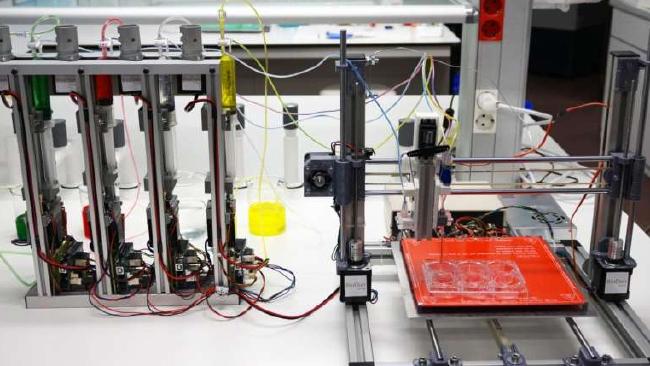Skin-Deep Bioprinting Innovation

Researchers in Spain have developed a prototype 3D bioprinter to produce human skin. Image courtesy of Universidad Carlos III de Madrid.
Latest News
July 19, 2017
South Korean scientists believe they have created a faster and less expensive way to 3D print human skin. The researchers at Pohang University of Science and Technology have demonstrated a single-step 3D cell printing strategy that could be an important development for reconstructive surgeries and other medical applications.
The hybrid system uses both extrusion and inkjet modules on the printer simultaneously. Using the printer, they were able to create a collagen-based material that features a polycaprolactone (PCL) membrane. PCL is a biodegradable polyester that prevents collagen contraction while the new tissue matures.
The research was printed in the journal Biofabrication.
 Prof. Dong-Woo Cho.
Prof. Dong-Woo Cho.“Although several approaches have been explored for developing biomimetic human skin models, the present skin models, which are still based on multistep production methods using polydimethylsiloxane (PDMS) chips and commercial cell culture inserts, could be limited in making a versatile design that facilitates the development of various functional human skin models,” said Professor Dong-Woo Cho, lead author of the paper. “In this regard, 3D cell-printing technique could establish a new era for advanced skin models.”
The human skin model the team created includes a functional transwell system (a scaffolding) that was fabricated using the extrusion modules along with a fibroblast-populated dermis. The inkjet dispensing module distributes skin cells (keratinocytes) on the engineered skin.
According to the report: “This skin model revealed favorable biological characteristics that included a stabilized fibroblast-stretched dermis and stratified epidermis layers after 14 days.”
“Significantly, our new method is around 50 times cheaper than alternative methods, and requires 10 times less base material,” Cho said. “We hope that this new single-step process could provide an attractive and useful platform for engineering fully functional human skin models.”
In related research, the video below explains the benefits of using a bioprinter to grow skin via a collaboration between scientists at Universidad Carlos III de Madrid (UC3M) and bio-engineering company BioDan Group.
Source: Science Daily
Subscribe to our FREE magazine, FREE email newsletters or both!
Latest News
About the Author
Brian Albright is the editorial director of Digital Engineering. Contact him at [email protected].
Follow DE





